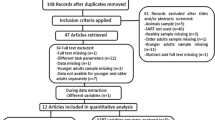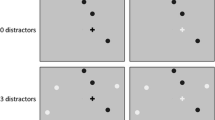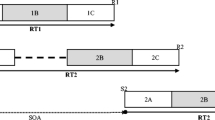Abstract
Despite decades of research on younger adults, little is known about the way in which vigilant attention is affected by healthy aging, and the small body of work that does exist has yielded mixed findings. Prior examinations of aging and vigilant attention have focused almost exclusively on sensory/perceptual tasks despite the fact that many real-world vigilance tasks are semantic in nature and it has been shown that older adults exhibit memory and attention deficits in semantic tasks in other domains. Here, we present the first empirical investigation of vigilant attention to verbal stimuli in healthy normal aging. In Experiment 1 we find that older adults are just as able as younger adults to identify critical targets defined by category membership (both overall and over time). In Experiment 2, we increase the difficulty of the task by changing the target category from one block to the next, but again find no age-group effects in accuracy. Response time data, however, show that older adults respond more slowly and subjective ratings indicate that older adults experience higher workload and arousal compared to their younger counterparts. The practical as well as theoretical implications of these findings are discussed.






Similar content being viewed by others
Notes
Due to participant recruitment limitations, it should be noted that females are over-represented in our sample. Some work has pointed to potential sex differences in sustained attention and language abilities however (Dittmar et al. 1993; Shaywitz et al. 1995 respectively). Excluding the males from our sample, while reducing experimental power, does not alter the findings in any qualitative manner between age groups.
While mean MEQ scores for both Younger and Older groups fell within the ‘neutral’ range (mean scores of 46.8 and 58.1 respectively), the Older group was significantly more ‘morning type’ than the Younger group, t (64) = 4.76, p < 0.001, d = 1.19. We do not consider the MEQ data any further.
A between-experiment analysis of Lure false alarm rates reveals a shallower decline in Lure false alarm rates in Experiment 2 than in Experiment 1 (F (5, 595) = 4.96, p < 0.001), however, this is simply driven by the fact that Lure false alarm rates in the first block of Experiment 2 are lower than in Experiment 1 (likely due to a more cautious approach to the task).
While the length of the distracter items do differ from that of both the target and lure items (p’s < 0.001), target and lure items do not differ in word length however (p = 0.70) and so deciding whether an item is a target or lure in the present experiments could not have been approached using a perceptual discrimination strategy.
References
Balota DA, Cortese MJ, Duchek JM, Adams D, Roediger HL III, McDermott KB, Yerys BE (1999) Veridical and false memories in healthy older adults and in dementia of the Alzheimer’s type. Cognit Neuropsychol 16:361–384
Berardi A, Parasuraman R, Haxby JV (2001) Overall vigilance and sustained attention decrements in healthy aging. Exp Aging Res 27:19–39
Brache K, Scialfa C, Hudson C (2010) Aging and vigilance: who has the inhibition deficit? Exp Aging Res 36:140–152
Bunce D (2001) The locus of age × health-related physical fitness interactions in serial choice responding as a function of task complexity: central processing or motor function? Exp Aging Res 27:103–122
Bunce D, Sisa L (2002) Age differences in perceived workload across a short vigil. Ergonomics 45:949–960
Bunce DJ, Barrowclough A, Morris I (1996) The moderating influence of physical fitness on age gradients in vigilance and serial choice responding tasks. Psychol Aging 11:671–682
Caggiano DM, Parasuraman R (2004) The role of memory representation in the vigilance decrement. Psychon Bull Rev 11:932–937
Caldeira JD (1980) Parametric assumptions of some” nonparametric” measures of sensory efficiency. J Human Factors Ergon Soc 22:119–120
Carriere JS, Cheyne JA, Solman GJ, Smilek D (2010) Age trends for failures of sustained attention. Psychol Aging 25:569–574
Connelly SL, Hasher L, Zacks RT (1991) Age and reading: the impact of distraction. Psychol Aging 6:533–541
Craig A (1978) Is the vigilance decrement simply a response adjustment towards probability matching? Human Factors. J Human Factors Ergon Soc 20:441–446
Craig A, Colquhoun WP (1977) Vigilance effects in complex inspection. In: Mackie RR (ed) Vigilance. Plenum Press, New York, pp 239–262
Davies DR, Hockey GRJ (1966) The effects of noise and doubling the signal frequency on individual differences in visual vigilance performance. Br J Psychol 57:381–389
Deaton JE, Parasuraman R (1993) Sensory and cognitive vigilance: effects of age on performance and subjective workload. Human Performance 6:71–97
Deese J (1959) On the prediction of occurrence of particular verbal intrusions in immediate recall. J Exp Psychol 58:17–22
Dempster FN (1992) The rise and fall of the inhibitory mechanism: toward a unified theory of cognitive development and aging. Dev Rev 12:45–75
Dittmar ML, Warm JS, Dember WN, Ricks DF (1993) Sex differences in vigilance performance and perceived workload. J Gen Psychol 120:309–322
Epling SL, Russell PN, Helton WS (2016) A new semantic vigilance task: vigilance decrement, workload, and sensitivity to dual-task costs. Exp Brain Res 234:133–139
Giambra LM (1997) Sustained attention and aging: overcoming the decrement? Exp Aging Res 23:145–161
Giambra LM, Quilter RE (1988) Sustained attention in adulthood: a unique, large-sample, longitudinal and multicohort analysis using the Mackworth Clock-Test. Psychol Aging 3:75–83
Green DM, Swets JA (1966) Signal detection theory and psychophysics. Wiley, New York
Grier JB (1971) Nonparametric indexes for sensitivity and bias: computing formulas. Psychol Bull 75:424–429
Hancock PA (2013) In search of vigilance: the problem of iatrogenically created psychological phenomena. Am Psychol 68:97–109
Hart SG (2006) NASA-task load index (NASA-TLX); 20 years later. In Proceedings of the Human Factors and Ergonomics Society Annual Meeting 50:904–908
Hart SG, Staveland LE (1988) Development of NASA-TLX (Task Load Index): results of empirical and theoretical research. Adv Psychol 52:139–183
Hartley AA (1993) Evidence for the selective preservation of spatial selective attention in old age. Psychol Aging 8:371–379
Hasher L, Zacks RT (1988) Working memory, comprehension, and aging: A review and new view. In: Bower GH (ed) The psychology of learning and motivation: Advances in research and theory, vol 22. Academic Press, New York, pp 193–225
Head H (1923) The conception of nervous and mental energy (II). Br J Psychol 14:126–147
Head J, Helton WS (2015) Passive perceptual learning versus active searching in a novel stimuli vigilance task. Exp Brain Res 233:1481–1489
Helton WS, Dember WN, Warm JS, Matthews G (1999) Optimism, pessimism, and false failure feedback: effects on vigilance performance. Current Psychology 18:311–325
Horne JA, Ostberg O (1975) A self-assessment questionnaire to determine morningness-eveningness in human circadian rhythms. Int J Chronobiol 4:97–110
Kahneman D (1973) Attention and effort. Prentice-Hall, Englewood Cliffs
Koelega HS, Brinkman JA, Hendriks L, Verbaten MN (1989) Processing demands, effort, and individual differences in four different vigilance tasks. Human Factors: J Human Factors Ergon Soc 31:45–62
Kucera N, Francis WN (1967) Computational analysis of present-day English. Brown University Press, Providene
Lustig C, Hasher L, Zacks RT (2007) Inhibitory deficit theory: recent developments in a “new view”. In: Gorfein DS, MacLeod CM (eds) The place of inhibition in cognition. American Psychological Association, Washington, DC, pp 145–162
Macdonald SW, Hultsch DF, Bunce D (2006) Intraindividual variability in vigilance performance: does degrading visual stimuli mimic age-related “neural noise”? J Clin Exp Neuropsychol 28:655–675
Mackworth NH (1948) The breakdown of vigilance during prolonged visual search. Quart J Exp Psychol 1:6–21
Mackworth, N. H. (1950). Researches on the measurement of human performance. (Medical Research Council Special Report Series No. 268). London, England: Her Majesty’s Stationary Office
Macmillan NA, Creelman CD (1996) Triangles in ROC space: history and theory of “nonparametric” measures of sensitivity and response bias. Psychon Bull Rev 3:164–170
Mayer JD, Gaschke YN (1988) The experience and meta-experience of mood. J Pers Soc Psychol 55:102–111
Mouloua M, Parasuraman R (1995) Aging and cognitive vigilance: effects of spatial uncertainty and event rate. Exp Aging Res 21:17–32
Nasreddine ZS, Phillips NA, Bédirian V, Charbonneau S, Whitehead V, Collin I, Chertkow H (2005) The Montreal Cognitive Assessment, MoCA: a brief screening tool for mild cognitive impairment. J Am Geriatr Soc 53:695–699
Parasuraman R (1979) Memory load and event rate control sensitivity decrements in sustained attention. Science 205:924–927
Parasuraman R, Davies DR (1977) A taxonomic analysis of vigilance performance. In: Mackie R (ed) vigilance. Springer, New York, pp 559–574
Parasuraman R, Giambra L (1991) Skill development in vigilance: effects of event rate and age. Psychol Aging 6:155–169
Parasuraman R, Nestor PG, Greenwood P (1989) Sustained-attention capacity in young and older adults. Psychol Aging 4:339–345
Peirce JW (2007) PsychoPy – Psychophysics software in Python. J Neurosci Methods 162:8–13
Roediger HL, McDermott KB (1995) Creating false memories: remembering words not presented in lists. J Exp Psychol Learn Mem Cogn 21:803–814
Shaw TH, Matthews G, Warm JS, Finomore VS, Silverman L, Costa PT (2010) Individual differences in vigilance: personality, ability and states of stress. J Res Pers 44:297–308
Shaywitz BA, Shaywitz SE, Pugh KR, Constable RT (1995) Sex differences in the functional organization of the brain for language. Nature 373:607
Shipley WC, Gruber CP, Martin TA, Klein AM (2009) Shipley-2 manual. Western Psychological Services, Los Angeles
Smit AS, Eling PA, Coenen AM (2004) Mental effort causes vigilance decrease due to resource depletion. Acta Physiol (Oxf) 115:35–42
Smith AD (1975) Partial learning and recognition memory in the aged. Int J Aging Human Dev 6:359–365
Staub B, Doignon-Camus N, Després O, Bonnefond A (2013) Sustained attention in the elderly: what do we know and what does it tell us about cognitive aging? Ageing Res Rev 12:459–468
Stoltzfus ER, Hasher L, Zacks RT (1996) Working memory and aging: Current status of the inhibitory view. In: Richardson JTE (ed) Working memory and human cognition. Oxford University Press, Cambridge, pp 66–88
Surwillo WW, Quilter RE (1964) Vigilance, age, and response-time. Am J Psychol 77:614–620
Thomson DR, Besner D, Smilek D (2015) A resource-control account of sustained attention: evidence from mind-wandering and vigilance paradigms. Perspect Psychol Sci 10:82–96
Thomson DR, Besner D, Smilek D (2016) A critical examination of the evidence for sensitivity loss in modern vigilance tasks. Psychol Rev 123:70–83
Titz C, Verhaeghen P (2010) Aging and directed forgetting in episodic memory: a meta-analysis. Psychol Aging 25:405–411
Verde MF, Macmillan NA, Rotello CM (2006) Measures of sensitivity based on a single hit rate and false alarm rate: the accuracy, precision, and robustness of, Az, and A′. Percept Psychophys 68:643–654
Warm JS, Howe SR, Fishbein HD, Dember WN, Sprague RL (1984) Cognitive demand and the vigilance decrement. In: Mital A (ed) Trends in ergonomics/human factors I. Elsevier, Amsterdam, pp 15–20
Wiener EL (1987) Application of vigilance research: rare, medium, or well done? Human Factors J Human Factors Ergon Soc 29:725–736
Williges RC (1973) Manipulating the response criterion in visual monitoring. Human Factors J Human Factors Ergon Soc 15:179–185
Witt JK, Taylor JET, Sugovic M, Wixted JT (2015) Signal detection measures cannot distinguish perceptual biases from response biases. Perception 44:289–300
Zacks RT, Radvansky G, Hasher L (1996) Studies of directed forgetting in older adults. J Exp Psychol Learn Mem Cogn 22:143–156
Author information
Authors and Affiliations
Corresponding author
Rights and permissions
About this article
Cite this article
Thomson, D.R., Hasher, L. On the preservation of vigilant attention to semantic information in healthy aging. Exp Brain Res 235, 2287–2300 (2017). https://doi.org/10.1007/s00221-017-4969-5
Received:
Accepted:
Published:
Issue Date:
DOI: https://doi.org/10.1007/s00221-017-4969-5




